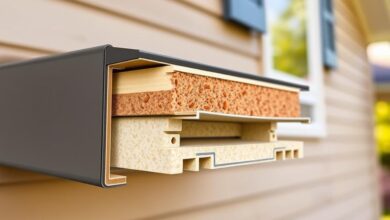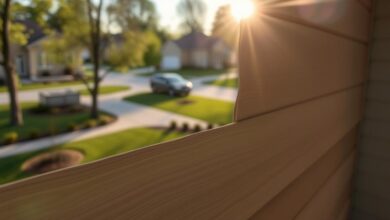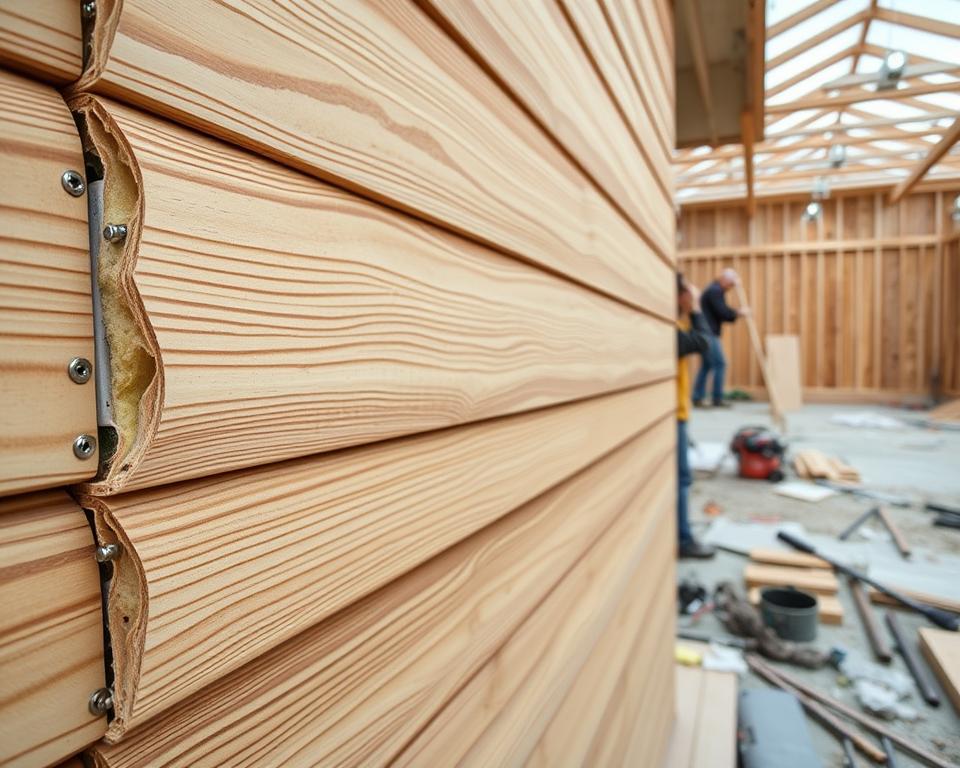The Ultimate Guide to Wood Insulated Siding
Looking for a durable and energy-efficient exterior for your home? Wood insulated siding is a great option. It combines natural beauty with practical benefits.
This ultimate guide will cover the advantages and key points of wood insulated siding. You’ll learn how it boosts your home’s look, saves energy, and lasts long against the weather.
Key Takeaways
- Benefits of using wood insulated siding for your home
- Key factors to consider when choosing wood insulated siding
- How wood insulated siding can improve energy efficiency
- Enhancing your home’s curb appeal with wood insulated siding
- Long-term durability and maintenance of wood insulated siding
Understanding Wood Insulated Siding and Its Benefits
Wood insulated siding is a new way to cover your home’s exterior. It mixes the look of wood with modern insulation. This makes your home look better and saves energy.
The Structure and Components of Wood Insulated Siding
Wood insulated siding has three main parts. The outside is made of strong, eco-friendly wood. The middle is insulation for keeping your home warm or cool. The back is a material that helps it stick to your house.
Energy Efficiency and Insulation Value
Wood insulated siding cuts down on energy use. It adds an extra layer of insulation. This means less heat escapes in winter and less heat gets in summer. You’ll save money on bills and help the planet.
| Insulation Type | R-Value | Energy Savings |
|---|---|---|
| Wood Insulated Siding | R-5 to R-7 | Up to 30% |
| Traditional Siding | R-1 to R-3 | Minimal |
Aesthetic Appeal and Design Versatility
Wood insulated siding also looks great and can match any style. You can pick from many wood types and finishes. This lets you find the perfect look for your home.
It’s a smart choice for those who want a beautiful home that saves energy. Wood insulated siding is a win-win for your home’s look and your wallet.
Popular Types of Wood Insulated Siding
Wood insulated siding comes in many forms, including different wood types and engineered products. Homeowners have a variety of choices. When picking, they think about durability, upkeep, cost, and looks.
Cedar Insulated Siding Options
Cedar is a favorite for wood insulated siding. It naturally fights off rot, decay, and bugs. Cedar insulated siding is both strong and beautiful, with a nice smell and look.
Pine and Spruce Insulated Panels
Pine and spruce are softwoods used for siding because they’re affordable and easy to find. They can be treated to last longer and are cheaper than cedar.
Engineered Wood Insulation Systems
Engineered wood mixes wood fibers or strands with adhesives. It’s more stable and less likely to warp or crack. Engineered wood systems work well and reliably.
Composite Wood Insulated Products
Composite wood products mix wood with plastics or metals. They’re more durable and need little care.
| Type of Wood Siding | Durability | Cost | Aesthetic Appeal |
|---|---|---|---|
| Cedar | High | Moderate to High | High |
| Pine/Spruce | Moderate | Low to Moderate | Moderate |
| Engineered Wood | High | Moderate | High |
| Composite Wood | Very High | High | Variable |
Preparing for Your Wood Insulated Siding Project
Starting a wood insulated siding project needs careful planning. You must have the right materials, tools, and know the costs. This ensures a successful installation.
Complete Materials Checklist
A detailed materials list is key for a smooth siding installation. You’ll need wood insulated siding panels, a moisture barrier, insulation, fasteners, and finishing trim. Having everything ready will avoid delays and extra costs.
| Material | Quantity | Purpose |
|---|---|---|
| Wood Insulated Siding Panels | As required | Primary siding material |
| Moisture Barrier | 1 roll | Protect against moisture |
| Insulation | As specified | Enhance energy efficiency |
Essential Tools for Professional Installation
Right tools are vital for a top-notch siding installation. You’ll need a circular saw, drill, hammer, tape measure, and level. Good tools ensure a precise and efficient job.
Cost Considerations and Budgeting
Knowing cost considerations is essential for a good budget. Costs depend on material quality, project size, and labor. A detailed budget keeps your project financially sound.
Step-by-Step Wood Insulated Siding Installation Guide
Installing wood insulated siding is a detailed process. It makes your home more energy-efficient and looks better. This guide will help you do it right.
Preparing Your Home’s Exterior Surface
Start by getting your home’s exterior ready. Take off any old siding and check the sheathing for damage. Make repairs if needed. Make sure the surface is clean, dry, and free of debris.
Inspection Checklist:
- Check for rotten or damaged sheathing
- Verify the integrity of the exterior surface
- Remove old siding and nails
Installing the Moisture Barrier and Insulation Layer
A moisture barrier stops water damage and keeps your siding lasting longer. Put a weather-resistant barrier over the sheathing, overlapping by at least 6 inches. Then, add insulation, making sure it fits well around windows and doors.
| Material | Purpose | Installation Tip |
|---|---|---|
| Moisture Barrier | Prevent water damage | Overlap sheets by 6 inches |
| Insulation Layer | Enhance energy efficiency | Ensure even distribution |
Measuring, Cutting, and Fitting Wood Panels
Getting the measurements right is key. Measure each wall section carefully, including windows and doors. Cut the wood panels and fit them tightly around any obstructions.
“The key to a successful siding installation is precision. Measure twice, cut once, and ensure a snug fit around all obstructions.”
Securing Panels and Creating Proper Seals
Start with the bottom panel and work up. Use the right fasteners to secure the panels, making sure they’re level and plumb. Seal edges and joints well to keep water out.
Finishing Touches and Trim Installation
After installing the panels, add trim around windows, doors, and corners. This improves looks and protects against weather.
By following these steps, you’ll get a professional wood insulated siding job. It will make your home look great and save energy for years.
Maintaining and Protecting Your Wood Insulated Siding
Keeping your wood insulated siding in top shape is key. Regular care keeps it working well and looking great.
Seasonal Inspection and Maintenance Schedule
It’s important to check your siding often. Look for damage, wear, or mold during the seasons. Make a schedule to keep your siding looking good all year.
Proper Cleaning Techniques and Products
Cleaning your siding right is important. Use a mild soap and avoid harsh chemicals. Soft washing is best to protect the siding and its finish.
Refinishing, Repairs, and When to Replace
As time goes by, your siding might need touch-ups or fixes. Watch its condition and fix problems fast. Knowing when to refinish or replace is key to keeping it looking and working well.
Conclusion
Wood insulated siding brings many benefits to homeowners. It boosts energy efficiency, looks great, and increases your home’s value.
Learning about the different types of wood insulated siding is important. Preparing your home and following a step-by-step guide helps. This way, you get a beautiful and lasting exterior.
Keeping your siding in good shape is essential. Regular checks and cleaning keep it looking and working well. This ensures your siding lasts longer.
This guide is for anyone wanting to improve their home’s exterior. Whether you’re experienced or new to DIY, you now have the knowledge to make smart choices. It’s all about making your home better.








